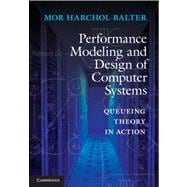
Note: Supplemental materials are not guaranteed with Rental or Used book purchases.
Purchase Benefits
What is included with this book?
| Introduction to Queueing | |
| Motivating examples | |
| Queueing theory terminology | |
| Necessary Probability Background | |
| Probability review | |
| Generating random variables | |
| Sample paths, convergence, and averages | |
| The Predictive Power of Simple Operational Laws: 'What If' Questions and Answers | |
| Operational laws | |
| Modification analysis | |
| From Markov Chains to Simple Queues | |
| Discrete-time Markov Chains | |
| Ergodicity theory | |
| Real-world examples: Google, Aloha | |
| Generating functions for Markov Chains | |
| Exponential distributions and Poisson Process | |
| Transition to continuous-time Markov Chains | |
| M/M/1 and PASTA | |
| Server Farms and Networks: Multi-server, Multi-queue Systems | |
| Server farms: M/M/k and M/M/k/k | |
| Capacity provisioning for server farms | |
| Time-reversibility and Burke's Theorem | |
| Jackson network of queues | |
| Classed network of queues | |
| Closed networks of queues | |
| Real-World Workloads: High-Variability and Heavy Tails | |
| Tales of tails: real-world workloads | |
| Phase-type workloads and matrix-analytic | |
| Networks of time-sharing (PS) servers | |
| M/G/I queue and inspection paradox | |
| Task assignment for server farms | |
| Transform analysis | |
| M/G/I transform analysis | |
| Power optimization application | |
| Smart Scheduling | |
| Performance metrics | |
| Non-preemptive, non-size-based policies | |
| Preemptive, non-size-based policies | |
| Non-preemptive, size-based policies | |
| Preemptive, size-based policies | |
| Scheduling: SRPT and fairness | |
| Table of Contents provided by Publisher. All Rights Reserved. |
The New copy of this book will include any supplemental materials advertised. Please check the title of the book to determine if it should include any access cards, study guides, lab manuals, CDs, etc.
The Used, Rental and eBook copies of this book are not guaranteed to include any supplemental materials. Typically, only the book itself is included. This is true even if the title states it includes any access cards, study guides, lab manuals, CDs, etc.